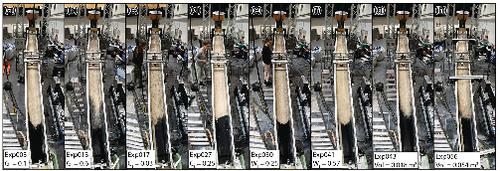当前位置:
X-MOL 学术
›
Earth Surf.Process. Land.
›
论文详情
Our official English website, www.x-mol.net, welcomes your
feedback! (Note: you will need to create a separate account there.)
Deciphering seismic and normal-force fluctuation signatures of debris flows: An experimental assessment of effects of flow composition and dynamics
Earth Surface Processes and Landforms ( IF 2.8 ) Pub Date : 2021-05-24 , DOI: 10.1002/esp.5168 T. Haas 1 , A. S. Åberg 1 , F. Walter 2 , Z. Zhang 2, 3
Earth Surface Processes and Landforms ( IF 2.8 ) Pub Date : 2021-05-24 , DOI: 10.1002/esp.5168 T. Haas 1 , A. S. Åberg 1 , F. Walter 2 , Z. Zhang 2, 3
Affiliation

|
Debris flows are gravity-driven mass movements that are common natural hazards in mountain regions worldwide. Previous work has shown that measurements of ground vibrations are capable of detecting the timing, speed, and location of debris flows. A remaining question is to what extent additional flow properties, such as grain-size distribution and flow depth can be inferred reliably from seismic data. Here, we experimentally explore the relation of seismic vibrations and normal-force fluctuations with debris-flow composition and dynamics. We use a 5.4 m long and 0.3 m wide channel inclined at 20°, equipped with a geophone plate and force plate. We show that seismic vibrations and normal-force fluctuations induced by debris flows are strongly correlated, and that both are affected by debris-flow composition. We find that the effects of the large-particle distribution on seismic vibrations and normal-force fluctuations are substantially more pronounced than the effects of water fraction, clay fraction, and flow volume, especially when normalized by flow depth. We further show that for flows with similar coarse-particle distributions seismic vibrations and normal-force fluctuations can be reasonably well related to flow depth, even if total flow volume, water fraction, and the size distribution of fines varies. Our experimental results shed light on how changes in large-particle, clay, and water fractions affect the seismic and force-fluctuation signatures of debris flows, and provide important guidelines for their interpretation.
中文翻译:

解读泥石流的地震和法向力波动特征:流动成分和动力学影响的实验评估
泥石流是重力驱动的大规模运动,是全球山区常见的自然灾害。先前的工作表明,地面振动的测量能够检测泥石流的时间、速度和位置。剩下的问题是在多大程度上可以从地震数据中可靠地推断出额外的流动特性,例如粒度分布和流动深度。在这里,我们通过实验探索地震振动和法向力波动与泥石流成分和动力学之间的关系。我们使用一个 5.4 m 长和 0.3 m 宽的通道,倾斜 20°,配备地震检波器板和测力板。我们表明,由泥石流引起的地震振动和法向力波动密切相关,并且两者都受泥石流成分的影响。我们发现大颗粒分布对地震振动和法向力波动的影响比水份、粘土份和流量的影响要明显得多,尤其是当按流深度归一化时。我们进一步表明,对于具有相似粗颗粒分布的流,地震振动和法向力波动可能与流深度有很好的相关性,即使总流量、水含量和细粒的粒度分布发生变化。我们的实验结果阐明了大颗粒、粘土和水组分的变化如何影响泥石流的地震和力波动特征,并为其解释提供重要指导。
更新日期:2021-05-24
中文翻译:

解读泥石流的地震和法向力波动特征:流动成分和动力学影响的实验评估
泥石流是重力驱动的大规模运动,是全球山区常见的自然灾害。先前的工作表明,地面振动的测量能够检测泥石流的时间、速度和位置。剩下的问题是在多大程度上可以从地震数据中可靠地推断出额外的流动特性,例如粒度分布和流动深度。在这里,我们通过实验探索地震振动和法向力波动与泥石流成分和动力学之间的关系。我们使用一个 5.4 m 长和 0.3 m 宽的通道,倾斜 20°,配备地震检波器板和测力板。我们表明,由泥石流引起的地震振动和法向力波动密切相关,并且两者都受泥石流成分的影响。我们发现大颗粒分布对地震振动和法向力波动的影响比水份、粘土份和流量的影响要明显得多,尤其是当按流深度归一化时。我们进一步表明,对于具有相似粗颗粒分布的流,地震振动和法向力波动可能与流深度有很好的相关性,即使总流量、水含量和细粒的粒度分布发生变化。我们的实验结果阐明了大颗粒、粘土和水组分的变化如何影响泥石流的地震和力波动特征,并为其解释提供重要指导。











































 京公网安备 11010802027423号
京公网安备 11010802027423号